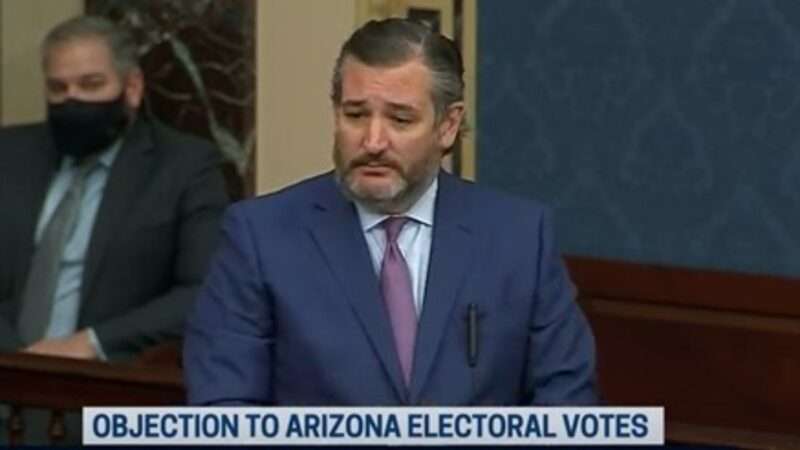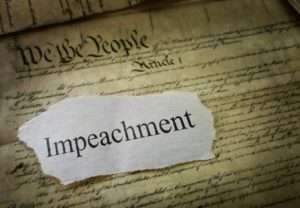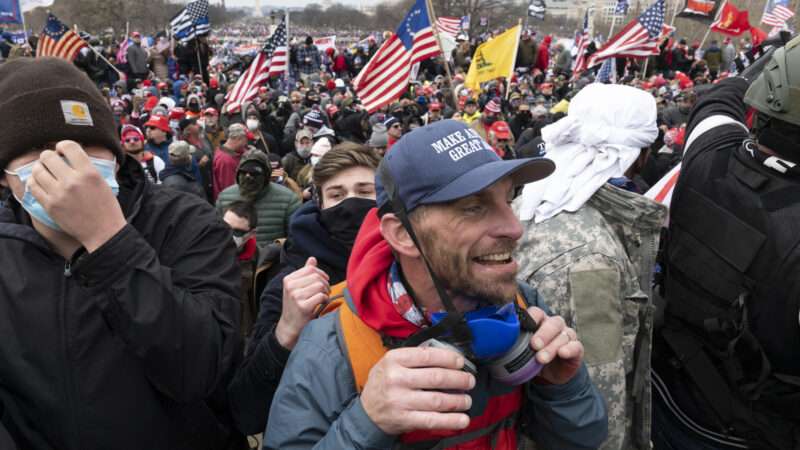
There is a lot of blame to go around for the poisonous delusions that led to yesterday’s riot at the Capitol, starting with a president who incited his followers with loony conspiracy theories and wild tales of a stolen election. But the disgraceful performance of Sen. Ted Cruz (R–Texas) should figure prominently in histories of this shameful incident. By contrast, Sen. Rand Paul (R–Ky.), who also has reinforced some of Donald Trump’s fraud claims and even toyed with the idea of objecting to electoral votes, stared into the constitutional abyss and stepped back.
Cruz was one of six senators who voted against recognizing Arizona’s electoral votes for President-elect Joe Biden last night and one of seven who supported the challenge to Pennsylvania’s electoral votes. Ostensibly, these objections were based on the claim that the votes were not “regularly given,” as required by the Electoral Count Act. Yet Cruz offered no reason to think that was true, meaning he had no legal basis for his objections.
Cruz presented his challenges as an attempt to assuage the doubts of Americans who think the election was “rigged” by appointing an “electoral commission” charged with conducting “a 10-day emergency audit” to investigate unfounded claims of systematic fraud that have been decisively rejected by state officials and the courts. He knew there was no way that was going to happen, but he pursued his objections anyway, even after yesterday’s pro-Trump chaos, vandalism, and violence led several of his erstwhile allies to reconsider their support for his plan. His pointless grandstanding lent credence to the unfounded accusations underlying the riot—accusations recklessly hurled by the same man Cruz himself has described as a “pathological liar” who “doesn’t know the difference between truth and lies”—while forsaking his oath to support and defend the Constitution.
“Recent polling shows that 39 percent of Americans believe the election that just occurred was ‘rigged,'” Cruz said when it was his turn to explain why he was objecting to Arizona’s electoral votes. “You may not agree with that assessment, but it is nonetheless a reality for nearly half the country….Even if you do not share that conviction, it is the responsibility, I believe, of this office to acknowledge that it is a profound threat to this country and to the legitimacy of any administrations that will come in the future.”
Cruz insisted that he wasn’t “arguing for setting aside this election.” His concern, he claimed, was that “tens of millions of Americans will see a vote against the objection as a statement that voter fraud doesn’t matter, isn’t real, and shouldn’t be taken seriously.” Dismissing their concerns, he said, “jeopardizes, I believe, the legitimacy of this and subsequent elections.”
What was missing from Cruz’s little speech? Any mention of evidence indicating that Arizona’s electoral votes were not properly certified, which is the only legal justification for rejecting them. A senator who takes his responsibilities seriously does not lodge an objection under the Electoral Count Act simply as an excuse for outlining a cockamamie scheme that supposedly will alleviate the doubts sown by a president whose fantasy that he actually won the election by a landslide is impervious to evidence.
Cruz’s maneuver was cowardly as well as legally groundless. Eager to appease the Republicans who live in Trump’s alternate universe without seeming like a kook, Cruz refuses to endorse or reject their beliefs. More than two months after the election, the closest he can come to admitting that Biden won is his concession that “our candidate may not have prevailed.” At the same time, he presents the widespread “conviction” that Trump won not as his personal belief but as a “reality” that somehow justifies setting aside duly certified electoral votes.
Senate Majority Leader Mitch McConnell (R–Ky.) shares Cruz’s concerns about voter fraud and election “irregularities.” But as he noted before Cruz spoke, “nothing before us proves illegality anywhere near the massive scale…that would have tipped the entire election.” He added that “public doubt alone” cannot “justify a radical break” from historical practice “when the doubt itself was incited without evidence.”
McConnell rejected the notion that humoring conspiracy theorists will somehow bring the nation together. “We cannot keep drifting apart into two separate tribes,” he said, “with a separate set of facts and separate realities, with nothing in common except our hostility towards each other and mistrust for the few national institutions that we all still share.”
McConnell warned that “if this election were overturned by mere allegations from the losing side, our democracy would enter a death spiral” and “we would never see the whole nation accept an election again.” Instead, “every four years would be a scramble for power at all cost.”
Cruz’s claim that he was not trying to overturn the election results is impossible to reconcile with his original plan, which involved objecting to electoral votes from six swing states, enough to change the outcome. “This objection is for the state of Arizona, but it is broader than that,” he said last night. “It is an objection for all six of the states.” In point of fact, it wasn’t. But if the Capitol Hill riot had not persuaded Cruz and his allies to scale back their objections, their efforts, if successful, would have done precisely what Cruz insisted he did not want to do.
Now consider what Rand Paul had to say about Cruz’s machinations:
Should Congress override the certified results from the states and nullify the states’ right to conduct elections? The vote today is not a protest; the vote today is literally to overturn the election!
Voting to overturn state-certified elections would be the opposite of what states’ rights Republicans have always advocated for. This would doom the Electoral College forever. It was never intended by our founders that Congress have the power to overturn state-certified elections.
My oath to the Constitution doesn’t allow me to disobey the law. I cannot vote to overturn the verdict of the states. Such a vote would be to overturn everything held dear by those of us who support the rights of states in this great system of federalism bequeathed to us by our founders.
The Electoral College was created to devolve the power of selecting presidential electors to the states. The Electoral College is, without question, an inseparable friend to those who believe that every American across our vast country deserves to be heard. If Congress were given the power to overturn the states’ elections…what terrible chaos would ensue. Imagine the furor against the Electoral College if Congress becomes a forum to overturn states’ Electoral College slates.
It is one thing to be angry. It is another to focus one’s anger in a constructive way. That hasn’t happened today, to say the least. We simply cannot destroy the Constitution, our laws, and the Electoral College in the process. I hope as the nation’s anger cools, we can channel that energy into essential electoral reforms in every state.
Paul is by no means blameless when it comes to vague allegations of election fraud. During a December 16 Senate hearing on election “irregularities,” he accepted the testimony of Christopher Krebs, who ran the Department of Homeland Security’s Cybersecurity and Infrastructure Security Agency until Trump fired him in a fit of pique on November 17, that vote-tabulating machines were not compromised, as the president has repeatedly alleged. But Paul said that does not mean “there was no problem in the elections.” He said he was concerned that “people broke the absentee [ballot] rules.” He also worried about votes by noncitizens and “dead people,” both of which are rare.
Later Paul declared that “fraud happened,” which no doubt is true, and “the election in many ways was stolen,” which is quite a leap. He added that “the only way it will be fixed is by in the future reinforcing the laws.”
In short, Paul has flirted with rhetoric similar to Trump’s but nevertheless agreed with McConnell that fraud was not pervasive enough to justify rejecting electoral votes. Cruz, by contrast, wanted to throw out electoral votes from Arizona and Pennsylvania without even bothering to allege that they were legally invalid. Whether or not you agree with Paul’s views about the merits of the Electoral College, his refusal to compromise his principles by going along with Cruz’s scheme shows that even loyal Trump supporters can find the courage to defy the president’s demands.
from Latest – Reason.com https://ift.tt/3hTyX6V
via IFTTT


